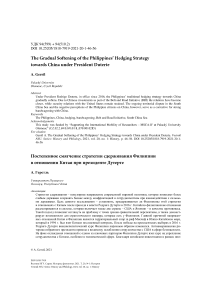The gradual softening of the Philippines’ hedging strategy towards China under president Duterte
Автор: Gerstl Alfred
Журнал: Вестник Новосибирского государственного университета. Серия: История, филология @historyphilology
Рубрика: Всеобщая история
Статья в выпуске: 1 т.20, 2021 года.
Бесплатный доступ
Under President Rodrigo Duterte, in office since 2016, the Philippines’ traditional hedging strategy towards China gradually softens. Due to Chinese investments as part of the Belt and Road Initiative (BRI) the relations have become closer, while security relations with the United States remain strained. The ongoing territorial dispute in the South China Sea and the negative perceptions of the Philippine citizens on China, however, serve as a corrective for strong bandwagoning with China.
The philippines, china, hedging, bandwagoning, belt and road initiative, south china sea
Короткий адрес: https://sciup.org/147220495
IDR: 147220495 | DOI: 10.25205/1818-7919-2021-20-1-46-56
Список литературы The gradual softening of the Philippines’ hedging strategy towards China under president Duterte
- Baviera A. President Duterte’s Foreign Policy Challenges. Contemporary Southeast Asia, 2016, vol. 38, iss. 2, p. 202–208.
- Estrada D. V. The Belt and Road Initiative and Philippine Participation in the Maritime Silk Road. Center for International Relations & Strategic Studies, 2017, vol. 4, iss. 7, p. 4–11.
- Gerstl A. The South China Sea Dispute: A Shift to a More Proactive Role in ASEAN’s Declamatory Policy and Concrete Policies since 2012? In: Unresolved Border, Land, and Maritime Disputes in Southeast Asia. Bi- and Multilateral Conflict Resolution Approaches and ASEAN’s Centrality. Leiden, Boston, Brill, 2017, p. 183–230.
- Goh E. Understanding ‘Hedging’ in Asia-Pacific Security. PacNet, 2006, iss. 43, p. 1–2.
- Gong X. The Belt & Road Initiative and China’s Influence in Southeast Asia. The Pacific Review, 2019, vol. 32, iss. 4, p. 635–665.
- Haacke J. The Concept of Hedging and its Application to Southeast Asia: a Critique and a Proposal for a Modified Conceptual and Methodological Framework. International Relations of the Asia-Pacific, 2019, vol. 19, iss. 3, p. 375–417.
- Hiep L. H. Vietnam’s Hedging Strategy against China since Normalization. Contemporary Southeast Asia, 2013, vol. 35, iss. 3, p. 333–368.
- Johnson D. T., Fernquest J. Governing through Killing: The War on Drugs in the Philippines. Asian Journal of Law and Society, 2018, vol. 5, iss. 2, p. 359–390.
- Kuik C.-C. Malaysia Between the United States and China: What do Weaker States Hedge Against? Asian Politics & Polity, 2016, vol. 8, iss. 1, p. 155–177.
- Kuik C.-C. The Essence of Hedging: Malaysia and Singapore’s Response to a Rising China. Contemporary Southeast Asia, 2008, vol. 30, iss. 2, p. 159–185.
- Permanent Court of Arbitration. PCA Case Nº 2013-19 in the Matter of the South China Sea Arbitration before an Arbitral Tribunal constituted under Annex VII to the 1982 UNCLOS between the Republic of the Philippines and the People’s Republic of China. The Hague, PCA, 2016. URL: https://pca-cpa.org/wp-content/uploads/sites/175/2016/07/PH-CN-20160712-Award.pdf (accessed 29 April 2020).
- Rabena A. J. The Complex Interdependence of China’s Belt and Road Initiative in the Philippines. Asia & The Pacific Policy Studies, 2018, iss. 5, p. 683–697.
- Regilme Jr., Salvador S. F. Beyond Paradigms: Understanding the South China Sea Dispute Using Analytic Eclecticism. International Studies, 2018, vol. 55, iss. 3, p. 213–237.
- Walt S. M. The Origins of Alliances. Ithaka, Cornell University Press, 1987, 336 p.
- Waltz K. N. Theory of International Politics. Reading, Addison-Wesley, 1979, 256 p.


